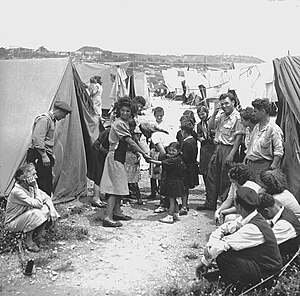One million plan
Utseende

One Million Plan (hebreiska: תוכנית המיליון) var en plan för mottagandet av en miljon judar från Europa, Mellanöstern och Nordafrika till det Brittiska Palestina på 18 månader. Detta som en central del i visionen, eller planen, på att upprätta en judisk stat. Efter en omröstning om planen i "Jewish Agency for Palestine" 1944, blev planen officiell policy för det dåvarande sionistiska styret som några år senare (1948) skulle komma att utropa sig som en självständig stat.[1][2][3][4]
Referenser
[redigera | redigera wikitext]- ^ Ehrlich, Mark Avrum (2009), Encyclopedia of the Jewish Diaspora: Origins, Experiences, and Culture, "1", ABC-CLIO, ISBN 978-1-85109-873-6, ”"A Zionist plan. designed in 1943–1944, to bring one million Jews from Europe and the Middle East to Palestine as a means and a stage to establish a state. It was the first time the Jews of Islamic countries were explicitly included in a Zionist plan."”
- ^ Meir-Glitzenstein 2004, sid. 44 #1: "After it was presented to the Jewish Agency Executive, the One Million Plan became the official policy of the Zionist leadership. The immigration of the Jews of Islamic countries was explicit or implicit in all the declarations, testimonies, memoranda and demands issued by the Jewish Agency from World War II until the establishment of the state."
- ^ Ofer 1991, sid. 239:"This tactical approach, the demand for "control of aliyah" and the immediate immigration of two million (later, one million) Jews, was the declared policy of the Jewish Agency Executive until the end of the war."
- ^ Ohana 2017, sid. 31: "The Million Plan was not an intellectual project or an abstract utopia with merely propagandist goals. It was a strategic move with extremely ambitious national, political, and techno-scientific goals, while being specific and concrete at the same time."
Vidare läsning
[redigera | redigera wikitext]- Barell, Ari; Ohana, David (2014). ”'The Million Plan': Zionism, Political Theology and Scientific Utopianism”. Politics, Religion & Ideology 15 (1): sid. 1–22. doi:. https://www.academia.edu/7035509.
- Hacohen, Dvorah (1991). ”Ben-Gurion and the Second World War”. i Jonathan Frankel. Studies in Contemporary Jewry : Volume VII: Jews and Messianism in the Modern Era: Metaphor and Meaning. Oxford University Press. ISBN 978-0-19-536198-8
- Hacohen, Dvora (1994). Tochnit hamillion [The One Million Plan] ("תוכנית המיליון, תוכניתו של דוד בן-גוריון לעלייה המונית בשנים 1942- 1945"). Tel Aviv: Ministry of Defense Publishing House
- Hacohen, Devorah (2003). Immigrants in Turmoil: Mass Immigration to Israel and Its Repercussions in the 1950s and After. Syracuse University Press. ISBN 978-0-8156-2969-6
- Eyal, Gil (2006). ”The "One Million Plan" and the Development of a Discourse about the Absorption of the Jews from Arab Countries”. The Disenchantment of the Orient: Expertise in Arab Affairs and the Israeli State. Stanford University Press. sid. 86–89. ISBN 978-0-8047-5403-3
- Katz, Irit (2016). ”Camp evolution and Israel's creation: between 'state of emergency' and 'emergence of state'”. Political Geography 55: sid. 144–155. doi:. https://www.academia.edu/29167751.
- Katz, Yossi (2000). ”Tourism in the Land of Israel in Mandate times: Programs by the Zionist establishment to advance the industry, 1940s until the establishment of the State”. i Pinhas Genosar. Revival of Israel Studies ("עיונים בתקומת ישראל"). Ben-Gurion University Press
- Kozlovsky, Roy (2011). ”Temporal States of Architecture: Mass Immigration and Provisional Housing in Israel”. i Isenstadt, Sandy; Rizvi, Kishwar. Modernism and the Middle East: Architecture and Politics in the Twentieth Century. University of Washington Press. sid. 139–160. ISBN 978-0-295-80030-1
- Meir-Glitzenstein, Esther (2004). ”The Reversal in Zionist Policy vis-a-vis the Jews of Islamic Countries: The One Million Plan”. Zionism in an Arab Country: Jews in Iraq in the 1940s. Routledge. sid. 35–47. ISBN 978-1-135-76862-1
- Ofer, Dalia (1991). Escaping the Holocaust illegal immigration to the land of Israel, 1939-1944. New York: Oxford University Press. ISBN 978-0-19-506340-0
- Ofer, Dalia (1991a). ”Illegal Immigration During the Second World War: Its Suspension and Subsequent Resumption”. i Jonathan Frankel. Studies in Contemporary Jewry : Volume VII: Jews and Messianism in the Modern Era: Metaphor and Meaning. Oxford University Press. ISBN 978-0-19-536198-8
- Ohana, David (5 juni 2017). Nationalizing Judaism: Zionism as a Theological Ideology. Lexington Books. ISBN 978-1-4985-4361-3. https://books.google.com/books?id=1CcnDwAAQBAJ&pg=PA31
- Picard, Avi (2018). ”Building the country or rescuing the people: Ben-Gurion's attitude towards mass Jewish immigration to Israel in the mid-1950s”. Middle Eastern Studies 54 (3): sid. 382–399. doi:. https://www.academia.edu/35608166.
- Rossetto, Piera (november 2012). Emanuela Trevisan Semi & Piera Rossetto. red. ”Space of Transit, Place of Memory: Ma'abarah and Literary Landscapes of Arab Jews; in Memory and Forgetting among Jews from the Arab-Muslim Countries. Contested Narratives of a Shared Past”. Quest. Issues in Contemporary Jewish History. Journal of Fondazione CDEC 4. Arkiverad från originalet den 26 september 2019. https://web.archive.org/web/20190926075154/http://www.quest-cdecjournal.it/focus.php?id=315. Läst 10 februari 2019.
- Segev, Tom (1998). 1949, the first Israelis. New York: Henry Holt. ISBN 978-0-8050-5896-3
- Shenhav, Yehouda (2006). The Arab Jews: A Postcolonial Reading of Nationalism, Religion, and Ethnicity. Stanford University Press. ISBN 978-0-8047-5296-1. https://books.google.com/books?id=k7FoMi-qY4kC
- På hebreiska: Shenhav, Yehouda (2003). הערבים היהודים. Am Oved. ISBN 978-965-13-1613-5. https://books.google.com/books?id=urptAAAAMAAJ
